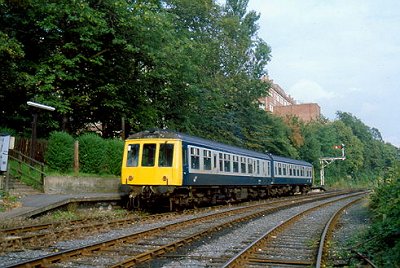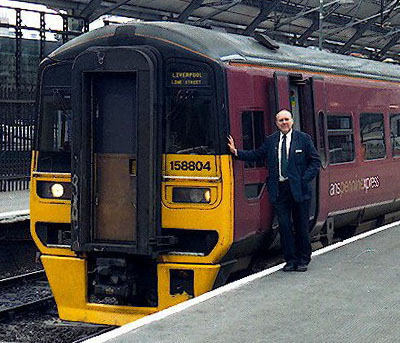Working the DMUs by Arno Brooks
My move to York
Although I am a Londoner I always felt that other places could offer a better quality of life. In the summer of 1984 I transferred to York. Although I was a soft southerner I was made to feel very welcome. It was a great place to work with a very wide variety of routes. There was DMU work as well as loco hauled passenger and freight. I worked on classes 03, 08, 20, 31, 37, 45, 46 and 47 as well as a smattering of 25s, 40s, 56s and HSTs.
One of the first things I noticed about the DMUs was that they were in much better condition than the Cricklewood Class 116s (the 127s had been replaced by EMUs by 1984). Obviously there was not a shortage of maintenance staff in the North of England. There was DMU work on the routes to Sheffield, Hull, Harrogate, Darlington, Doncaster, Scarborough and Leeds. There were several classes of unit than I had not previously driven. For the first time I drove the very pleasant Class 110 Calder Valley units. All DMUs have good all-round visibility but the 110s were better than the rest. In addition I also drove 101s 104s, 112s and 114s. All these units handled and performed very much like the old 116s from the Midland and there were no great surprises.

The huge Rowntrees factory at York had its own staff halt. Each morning a train ran from Doncaster via Selby and York and terminated at Rowntrees halt. A similar train ran the other way in the evening. Rowntrees also had its own good yard and Sentinel diesel shunter. All is of course now history. BR was good at losing traffic and closing facilities. I had just brought this unit empty from York's Clifton Carriage sidings for a run to Doncaster. A Summers evening, 1985. Arno Brooks.
There were, however two types of unit very strange to me. On weekday evenings there was a job from Doncaster that comprised of a Gloucester RC&W single car parcels unit, usually towing a single Mark 1 full-brake coach. The first time I entered the cab of one of these things I could not find the AWS unit to switch it on. I searched for ages. Then it dawned on me. There wasn’t one. I had seen the old Southern EMUs without AWS but I never expected to find a train without AWS on the East Coast Main Line. Strangeness aside the Gloucester single car and tail van performed similar to any twin unit.
The other DMU that stands out in my memory was a very ancient Gloucester RC&W two car unit. It was a pampered old creature in very nice condition. I believe that it lived in a shed at Doncaster works. It had a departmental number and was known as the York Saloon. It was for the use of the General Manager of the Eastern Region and was used for management excursions and inspection tours. One car had a very large wooden boardroom table and about a dozen well upholstered dining chairs. There were also several very comfortable high backed, winged armchairs. Behind the cabs were a couple of rows of seats rather like cinema seats so that everybody could look forward when inspecting the route. Both cars had a polished lino floor and a dark blue carpet. All upholstery was in a dark old 1950s period British Railways first class moquette fabric. There was also a small kitchen for making light meals and hot drinks. Everything was clean, neat and tidy. It was a wonderful little train. I was lucky enough to drive this set on four occasions. Twice as an empty stock movement and twice with various Eastern Region and BR Board big-wigs. I was well looked after and received plenty of tea, sandwiches, cakes and biscuits. On one of these jaunts we were stopped on the down East Coast Mainline just south of Croxdale viaduct between Darlington and Durham. Somebody was standing on the viaduct parapet and threatening to jump into the River Wear below. The police dealt with the matter and the person was eventually led away. I was a crime to scrap the York Saloon.
Covered in brown stuff and looking very stupid
If you don’t know what it is leave it alone. We all know that don’t we? Well I forgot it. The very last time that I drove a DMU was in autumn of 1996. I was at York and with privatisation I had opted to work for Rail Express Systems. RES was later to become the original part of EWS. RES’s core work was the Royal Mail traffic but it would take on virtually any type of train that a normal Train Operating Company could not or would not do. This included ferrying just about any sort of train from one place to another.
One day I was sent to Doncaster to pick up a DMU converted for Sandite use. I was to take this unit to the big maintenance depot at Heaton, north of Newcastle. I arrived at Doncaster and found the unit in the sidings behind the station. It was a 2 car Derby Lightweight unit still in the old BR blue and grey. All the seats were still in place but everything was very tatty. In the guard’s brake compartment was the Sandite equipment. I started the unit’s engines and let them run up and then prepared the set for its run. I still had a lot of time before my booked departure time so I decided to examine the Sandite equipment.
The main component was a vertical drum about four feet in diameter and about six feet tall. It was open topped but too high to see inside. Close by was an air reservoir and lots of piping, rubber hoses, air cocks and a couple of levers. There was the hissing sound of compressed air gently escaping from the pipe work. Being the general expert that I am, I decided to have a play with this equipment. Not that I knew what I was doing, but I though “what can possibly go wrong?” I opened a large air cock, not much happened at first. There was a slight increase in the hissing sound and then from the drum could be heard a “glump glump glump” sound. Then the drum emitted a very loud “shpooofff” followed by a volcanic eruption of wet, sticky, brown sandite. It hit the ceiling and showered all over the brake compartment. I quickly shut off the air cock and legged it.
The Sandite was all over the floor, walls and me. Imagine wallpaper paste full of sand. That is what Sandite is like. It was in my hair and all over my jacket and trousers. I spent the next 15 minutes trying to clean myself up. Eventually I arrived at Heaton and stabled the unit. I still looked pretty disgusting and the stuff had by then dried and gone crusty. I had to travel on the Newcastle Metro from Chillingham Road to Newcastle Central Station and then on a 225 back to York. People looked at me but kept well away. One Newcastle driver saw me and called out “Noo then Brooksie, ya look pretty canny today, is that hair gel like”? Thus my career on DMUs ended in a blaze of brown sticky stuff.
The last chapter
Eventually Rail Express Systems was bought by the American company, Wisconsin Central and we became EWS. In the process three other freight companies were absorbed. Transrail, Mainline and Loadhaul joined forces with us. It soon became very apparent that the freight people were greedily eyeing up our prestigious high speed mail trains. Everyone wanted a slice of our action. We came under several new managers who firmly believed the Wisconsin Central management philosophy of threaten, belittle and kick ass. Luckily I saw the writing on the wall before most of my colleagues. It was time to escape.
In the summer of 1997 I quit EWS and became a driver for Regional Railways Northeast at York. Once again I was on diesel multiple units, albeit modern Sprinters and class 158s. After a session of route refreshing I was back driving passenger units. One evening I arrived at Sheffield with a class 156 unit from York. I got the surprise of my life. There on an adjacent platform was a shiny green 2 car Metro-Camel DMU. Had a time warp transported me back to 1962?
I had honestly thought that the DMUs had gone. They were still alive and kicking and working out of Manchester Piccadilly. Not long after, I learned the trans-Pennine routes and drove trains to Liverpool and Manchester Airport. Once again I saw DMUs on an almost daily basis. Gradually North West Trains acquired new class 175 units and the DMU’s slow decline continued. By the autumn of 2003 there were only six class 101s units still in service. One was the green unit that I originally saw at Sheffield; it had the nick-name of Daisy. Another was in the orange and black colours of Strathclyde transport. Another was in the old Network Southeast colours and the rest were in the Regional Railways light grey and blue. Passing Longsight depot on the way to Manchester Airport I saw many other condemned DMUs awaiting the inevitable.
One evening in December 2003 I was in Manchester Piccadilly with a Transpennine Express class 158. On an adjacent platform was a brand new Virgin Pendolino and on the platform next to mine was an old Class 101 quietly rattling to itself. It occurred to me that the Pendolino will still be in service in the year 2033. The DMU had probably been made in 1958. When the DMU was still new it would have rubbed shoulders with old tank engines built in the 1880s. This old DMU was a go-between to over 150 years of railway history. By New Year 2004 they had all gone.

A recent picture of your author at Liverpool Lime Street. I had just worked this train from York via Leeds, Huddersfield, Stalybridge, Manchester Piccadilly, Warrington and on to Liverpool.
Monday 26th April 2004. Last night a single car DMU passed through York. It was too dark to see its details but it made a nice sight. When is the end not really the end?
When I was in my teens and early twenties I loved to visit railways like the Bluebell and the Worth Valley. It was a real treat to see the old steam locos. Recently when I visited the Swanage Railway and the West Somerset line I found myself riding on preserved DMUs. No doubt, one day a preserved Virgin Voyager will strut its stuff on the Severn Valley or East Lancs Railway. May I live to see the day.
Arno Brooks


